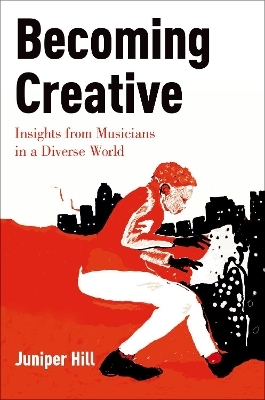
Becoming Creative
Oxford University Press Inc (Verlag)
978-0-19-936517-3 (ISBN)
How are our ability and motivation to be creative shaped by the world around us? Why does creativity seem to flourish in some environments, while others seem to stifle it? Many societies value creativity as an abstract concept and many, perhaps even most, individuals feel an internal drive to be creative; however, tremendous social pressures restrict individuals' development of creative skill sets, engagement in creative activities, and willingness to take creative risks.
Becoming Creative explores how social and cultural factors enable or inhibit creativity in music. Author Juniper Hill integrates perspectives from ethnomusicology, education, sociology, psychology, and performance studies, while prioritizing the voices of practicing musicians and music educators. Insights are drawn from ethnographic research and in-depth interviews with classical, jazz, and traditional musicians in South Africa, Finland, and the US. By comparing and analysing these musicians' personal experiences, Becoming Creative deepens our understanding of the development and practice of musical creativity, the external factors that influence it, and strategies for enhancing it. Hill reveals the common components of how musical creativity is experienced across these cultures and explains why creativity might not always be socially desirable. She identifies ideal creativity-enabling criteria -- specific skills sets, psychological traits and states, and access to opportunities and authority -- and illustrates how these enablers of creativity are fostered or thwarted by a variety of beliefs, attitudes, learning methods, social relationships, institutions, and social inequalities. In addition to theoretical contributions, many sections have direct applications for practice, especially the examination of formal and informal strategies for overcoming inhibitors of creativity. Becoming Creative is for scholars, artists, educators, and anyone wishing to better understand and support creative development in today's world.
Juniper Hill has conducted extensive fieldwork on creativity, improvisation, pedagogy, and intercultural dynamics in South Africa, Finland, the US, and Ecuador. She has been awarded a Marie Curie fellowship, a Humboldt fellowship, and two Fulbright fellowships, and has held positions at the University of California, University of Cambridge, and University College Cork. She is currently Professor and Chair of Ethnomusicology at the University of Würzburg.
Table of Contents
Acknowledgments
List of Figures
Chapter One:
Interpreting Creative Experience Across Diverse Musical Communities
1.1. Introduction
1.2. What does it mean to be creative?
An experiential model of musical creativity
Generativity
Agency
Interaction
Nonconformity
Recycling
Flow
Value as a problematic component of creativity
1.3. Creativity as socially undesirable behavior: some theoretical insights
Social pressures to conform
Internalizing motivations not to be creative
1.4. Common enablers and inhibitors of creativity: an overview of chapters
1.5. Learning from the experiences of musicians: methodology
1.6. Contrasting musical communities: the case studies
The allure of Helsinki, Cape Town, and Los Angeles as research sites
Urban distinctions
Cross-cultural comparisons of classical, jazz, and folk music communities
Chapter Two:
Developing Creativity Enabling Skills
2.1. Introduction to creativity enabling skills
2.2. Technique
The myth of technical mastery as prerequisite for creativity
Overemphasis on technique
Correct technique as conformativity or toolbox
2.3. Aural skills
Building aural skills through oral transmission
Lack of aural skills as inhibiting
Concerns about oral transmission and imitation
2.4. Vocabulary and memory facility
Building vocabulary for idiomatic creative activities
Human memory as facilitator of creativity
Oral versus written culture
Reviving oral culture and unfixing notation
A critique of pattern manipulation as (un)creative
2.5. Syntax and the ability to apply music theory
2.6. Decision-making skills
Lack of decision-making skills as inhibiting
Approaches for fostering decision-making skills
2.7. Self-assessment skills
2.8. Summary of developing creativity enabling skills
Chapter Three:
Developing Psychological Enablers and Inhibitors of Creativity
3.1. Introduction to psychological enablers and inhibitors of creativity
3.2. Beliefs about talent and potential
Western attitudes toward talent and their impacts
South African attitudes toward musical and creative potential and their impacts
3.3. Role models
Identification with role models and sense of potential
Role models as conveyors of norms and permission
3.4. Assessment and feedback
Positive feedback
Constructive critical assessment
Destructive feedback
Anticipating feedback
Self-judgment
3.5. Values and attitudes
Mistakes and Perfectionism
Originality versus recycling
3.6. Summary of psychological enablers and inhibitors
Chapter Four:
Accessing the Opportunity, Permission, and Authority to be Creative
4.1. Opportunities and barriers in creative development: social inequalities
Prejudice and internalized perceptions of limited potential
Economic inequalities in music learning
4.2. Opportunities and barriers in creative work: economic pressures
Private gigs, corporate sponsorship, and neoliberal policies in Cape Town
Working for the music, television, and film industries in Los Angeles
State support for the arts in Helsinki
Policies, markets, motivation, and education
4.3. Authority, permissions, and prohibitions: who's allowed to create what music?
Codifying rules for newcomers and restricting outsiders
Stylstic boundaries and the politics of race, class, and cultural imperialism
Internalizing musical attitudes and practices as moral values
4.4. Summary of societal enablers and inhibitors of creativity
Chapter Five:
Overcoming Inhibitors of Creativity
5.1. Mechanisms for overcoming inhibitors of creativity
The safe transgression of comfort zones
5.2. Formal methods for enhancing creative agency: courses and programs
Safety and emotional support
Facilitating composition and improvisation within an idiom
Free improvisation, experimentalism, and the breaking of convention
Multiple modes of expression: singing, multi-instrumentalism, dance, and theatre
Exposure, facilitator expectations, and validation
5.3. Informal strategies for overcoming creative hurdles: individual journeys
Tuomas
Jackie
Kyle
Anja
Juniper
5.5. Conclusions on increasing creative agency
Musicians Interviewed
References
| Erscheinungsdatum | 02.11.2018 |
|---|---|
| Zusatzinfo | 5 line, 14 halftone |
| Verlagsort | New York |
| Sprache | englisch |
| Maße | 236 x 160 mm |
| Gewicht | 522 g |
| Themenwelt | Kunst / Musik / Theater ► Musik ► Musiktheorie / Musiklehre |
| ISBN-10 | 0-19-936517-2 / 0199365172 |
| ISBN-13 | 978-0-19-936517-3 / 9780199365173 |
| Zustand | Neuware |
| Informationen gemäß Produktsicherheitsverordnung (GPSR) | |
| Haben Sie eine Frage zum Produkt? |
aus dem Bereich


